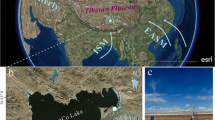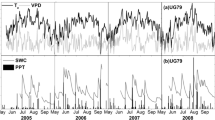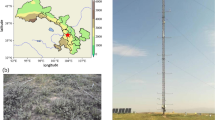Abstract
Wet grasslands in the Brazilian Cerrado occupy around 1 % of the Cerrado extension, acting as ecotones connecting well-drained savanna vegetation and gallery forest. Wet grasslands help maintain biodiversity and water balance, and are an important component of the carbon (C) balance, storing an average of 241 MgC h−1 in the top 60 cm soils. However, in addition to increased climactic variability, Brazilian wet grasslands are under pressure from domestic water use and agricultural irrigation. Here, we present 2 years of carbon balance data from a Brazilian wet grassland, which was exposed to below average seasonal and annual precipitation during the first year and excess precipitation during the second year. We used the eddy covariance approach to measure net ecosystem carbon exchange (NEE) and ecosystem respiration (R e). Results indicated that the wet grassland was a carbon sink during both years, taking up similar amounts each year (−86.5 gC m−2 year−1 in 2005 and −81.3 gC m−2 year−1 in 2006). However, seasonal NEE was variable and driven by fluctuations in the water table depth (P < 0.05), shifting the balance from a carbon sink to a carbon source from 1 month to the next by as much as 50 gC m−2 when water table dropped below 20 cm depth. The gross ecosystem carbon uptake (GEE) decreased with water table depth, while Re increased due to the exposure of old organic carbon to microbial decomposition. Results indicated that a prolonged drought, which is probable under future projected climatic variability, could lead the ecosystem to be a carbon source and highlight the importance of management strategy in preserving soil water in these ecosystems.




Similar content being viewed by others
References
Aubinet M et al (2000) Estimates of the annual net carbon and water exchange of forests: the EUROFLUX methodology. Adv Ecol Res 30(30):113–175
Baldocchi DD (2003) Assessing the eddy covariance technique for evaluating carbon dioxide exchange rates of ecosystems: past, present and future. Glob Change Biol 9(4):479–492
Bernal B, Mitsch WJ (2008) A comparison of soil carbon pools and profiles in wetlands in Costa Rica and Ohio. Ecol Eng 34(4):311–323
Bonneville M-C, Strachan IB, Humphreys ER, Roulet NT (2008) Net ecosystem CO2 exchange in a temperate cattail marsh in relation to biophysical properties. Agric For Meteorol 148(1):69–81
Chimner RA, Cooper DJ (2003) Influence of water table levels on CO2 emissions in a Colorado subalpine fen: an in situ microcosm study. Soil Biol Biochem 35(3):345–351
Christensen JH, Krishna Kumar K, Aldrian E, An S-I, Cavalcanti IFA, de Castro M, Dong W, Goswami P, Hall A, Kanyanga JK, Kitoh A, Kossin J, Lau N-C, Renwick J, Stephenson DB, Xie S-P, Zhou T (2013) Climate phenomena and their relevance for future regional climate change. In: Stocker TF, Qin D, Plattner G-K, Tignor M, Allen SK, Boschung J, Nauels A, Xia Y, Bex V, Midgley PM (eds) Climate change 2013: the physical science basis. Contribution of working Group I to the fifth assessment report of the intergovernmental panel on climate change. Cambridge University Press, Cambridge
Dusek J et al (2009) Influence of summer flood on the net ecosystem exchange of CO2 in a temperate sedge-grass marsh. Agric For Meteorol 149(9):1524–1530
Dusek J, Cizkova H, Stellner S, Czerny R, Kvet J (2012) Fluctuating water table affects gross ecosystem production and gross radiation use efficiency in a sedge-grass marsh. Hydrobiologia 692(1):57–66
Falge E et al (2001) Gap filling strategies for defensible annual sums of net ecosystem exchange. Agric For Meteorol 107(1):43–69
Ferreira EAB, Meirelles ML, Franco AC, Santos JLM (2009) Influência de variações ambientais sobre o fluxo de CO2 em solos sob Campo Limpo Úmido no Cerrado (Influence of environmental changes on the CO2 flow in wet grassland Cerrado soil). In: Faleiro FG, Farias Neto AL (eds) Menções honrosas: IX Simpósio Nacional do Cerrado e II Simpósio Internacional de Savanas Tropicais. Embrapa Cerrados, DF, Brasil, pp 238–242
Foken T, Wichura B (1996) Tools for quality assessment of surface-based flux measurements. Agric For Meteorol 78(1–2):83–105
Furley PA, Ratter JA (1988) Soil resources and plant-communities of the central Brazilian cerrado and their development. J Biogeogr 15(1):97–108
Goulden ML, Munger JW, Fan SM, Daube BC, Wofsy SC (1996) Exchange of carbon dioxide by a deciduous forest: response to interannual climate variability. Science 271(5255):1576–1578
Hao YB et al (2011) Predominance of precipitation and temperature controls on ecosystem CO2 exchange in zoige alpine wetlands of southwest China. Wetlands 31(2):413–422
Hirota M et al (2006) Carbon dioxide dynamics and controls in a deep-water wetland on the Qinghai-Tibetan Plateau. Ecosystems 9(4):673–688
Hooijer A et al (2010) Current and future CO2 emissions from drained peatlands in Southeast Asia. Biogeosciences 7(5):1505–1514
IPCC (2013) Annex I: atlas of global and regional climate projections [van Oldenborgh GJ, Collins M, Arblaster J, Christensen JH, Marotzke J, Power SB, Rummukainen M, Zhou T (eds)]. In: Climate change 2013: the physical science basis. Contribution of working Group I to the fifth assessment report of the intergovernmental panel on climate change [Stocker TF, Qin D, Plattner G-K, Tignor M, Allen SK, Boschung J, Nauels A, Xia Y, Bex V, Midgley PM (eds)]. Cambridge University Press, Cambridge, UK and New York, NY, USA
Jackson RB et al (1996) A global analysis of root distributions for terrestrial biomes. Oecologia 108(3):389–411
Kansiime F, Saunders MJ, Loiselle SA (2007) Functioning and dynamics of wetland vegetation of Lake Victoria: an overview. Wetlands Ecol Manage 15(6):443–451
Kormann R, Meixner FX (2001) An analytical footprint model for non-neutral stratification. Bound-Layer Meteorol 99(2):207–224
Lehner B, Doll P (2004) Development and validation of a global database of lakes, reservoirs and wetlands. J Hydrol 296(1–4):1–22
Lloyd CR (2006) Annual carbon balance of a managed wetland meadow in the Somerset Levels, UK. Agricultural and Forest Meteorology 138(1–4):168–179
Lund M et al (2010) Variability in exchange of CO2 across 12 northern peatland and tundra sites. Glob Change Biol 16(9):2436–2448
Mack MC et al (2011) Carbon loss from an unprecedented Arctic tundra wildfire. Nature 475(7357):489–492
Meirelles ML, Guaimarães AJM, Oliveira RC, Glein MA, Ribeiro FF (2004) Impactos sobre o estrato herbáceo de Áreas Úmidas do Cerrado (Impacts on the herbaceous layer of the Cerrado Wetlands). In: Aguiar LM, Camargo AJA (eds) Cerrado: ecologia e caracterização. Embrapa Cerrados, Brasilia, pp 41–68
Mitra S, Wassmann R, Vlek PLG (2005) An appraisal of global wetland area and its organic carbon stock. Curr Sci 88(1):25–35
Mitsch WJ et al (2008) Tropical wetlands for climate change research, water quality management and conservation education on a university campus in Costa Rica. Ecol Eng 34(4):276–288
Mitsch WJ et al (2010) Tropical wetlands: seasonal hydrologic pulsing, carbon sequestration, and methane emissions. Wetlands Ecol Manag 18(5):573–586
Moncrieff JB et al (1997) A system to measure surface fluxes of momentum, sensible heat, water vapour and carbon dioxide. J Hydrol (Amsterdam) 188–189(1/4):589–611
Myers N, Mittermeier RA, Mittermeier CG, da Fonseca GAB, Kent J (2000) Biodiversity hotspots for conservation priorities. Nature 403(6772):853–858
Oliveira-Filho AT, Ratter JA (2002) Vegetation physiognomies and woody flora of the Cerrado biome. In: Oliveira PS, Marquis RJ (eds) The Cerrado of Brazil: ecology and natural history of a neotropical savanna. Columbia University Press, New York, pp 91–120. ISBN 0-231-12043-5
Ovenden L (1990) Peat accumulation in northern wetlands. Quatern Res 33(3):377–386
Ribeiro JF, Walter BMT (1998) Fitofisionomias do Bioma Cerrado. In: Sano SM, Almeida SP (eds) Cerrado: ambiente e flora. Embrapa Cerrado, Brasília, pp 89–166
Rocha HRD et al (2002) Measurements of CO2 exchange over a woodland savanna (Cerrado Sensu stricto) in southeast Brasil. Biota Neotropica 2(1):1–11
Rodrigues Munhoz CB, Felfili JM (2008) Phytosociology of the herb-subshrub layer of a moist grassland community in Central Brazil. Acta Botanica Brasilica 22(4):905–913
Sano EE, Rosa R, Brito JLS, Ferreira LG (2008) Mapping the Cerrado’s vegetation cover. Boletim de Pesquisa e Desenvolvimento—Embrapa Cerrados (205):60
Saunders MJ, Jones MB, Kansiime F (2007) Carbon and water cycles in tropical papyrus wetlands. Wetlands Ecol Manag 15(6):489–498
Saunders MJ, Kansiime F, Jones MB (2014) Reviewing the carbon cycle dynamics and carbon sequestration potential of Cyperus papyrus L. wetlands in tropical Africa. Wetlands Ecol Manag 22(2):143–155
Sonnentag O, van der Kamp G, Barr AG, Chen JM (2010) On the relationship between water table depth and water vapor and carbon dioxide fluxes in a minerotrophic fen. Glob Change Biol 16(6):1762–1776
Suzuki S, Ishida T, Nagano T, Waijaroen S (1999) Influences of deforestation on carbon balance in a natural tropical peat swamp forest in Thailand. Environ Control Biol 37(2):115–128
von Randow C et al (2013) Inter-annual variability of carbon and water fluxes in Amazonian forest, Cerrado and pasture sites, as simulated by terrestrial biosphere models. Agric For Meteorol 182:145–155
Webb EK, Pearman GI, Leuning R (1980) Correction of flux measurements for density effects due to heat and water-vapor transfer. Q J R Meteorol Soc 106(447):85–100
Zhou L, Zhou G, Jia Q (2009) Annual cycle of CO2 exchange over a reed (Phragmites australis) wetland in Northeast China. Aquat Bot 91(2):91–98
Acknowledgments
This study was supported by the Agricultural Technology Development Project for Brazil (PRODETAB), negotiated between the Brazilian government and the World Bank. The authors thank the computational support of Dr. Celso von Randow of the National Institute for Space Research (INPE-Brazil), and the fieldwork assistance provided by the technical experts Edim Borges Vieira, Nelson de Oliveira Pais, and Valdeci de Matos Lima of the Brazilian Agricultural Research Corporation (EMBRAPA). R. Bracho was supported by the U.S. Department of Energy Office of Science Award Number DE-FG02-99ER62848 while working on this manuscript. The authors thank Elizabeth Weeb for proofreading the manuscript.
Author information
Authors and Affiliations
Corresponding author
Rights and permissions
About this article
Cite this article
Meirelles, M.L., Bracho, R. & Ferreira, E.A.B. Carbon dioxide exchange in a tropical wet grassland. Wetlands Ecol Manage 23, 817–826 (2015). https://doi.org/10.1007/s11273-015-9421-7
Received:
Accepted:
Published:
Issue Date:
DOI: https://doi.org/10.1007/s11273-015-9421-7




